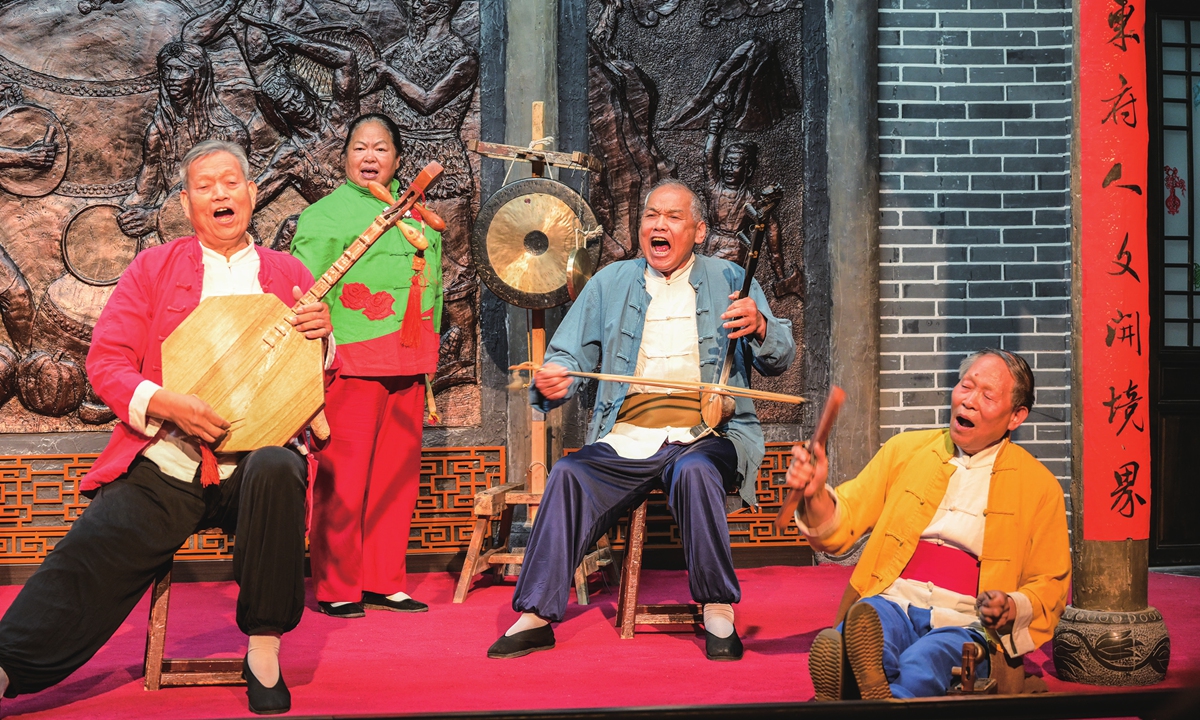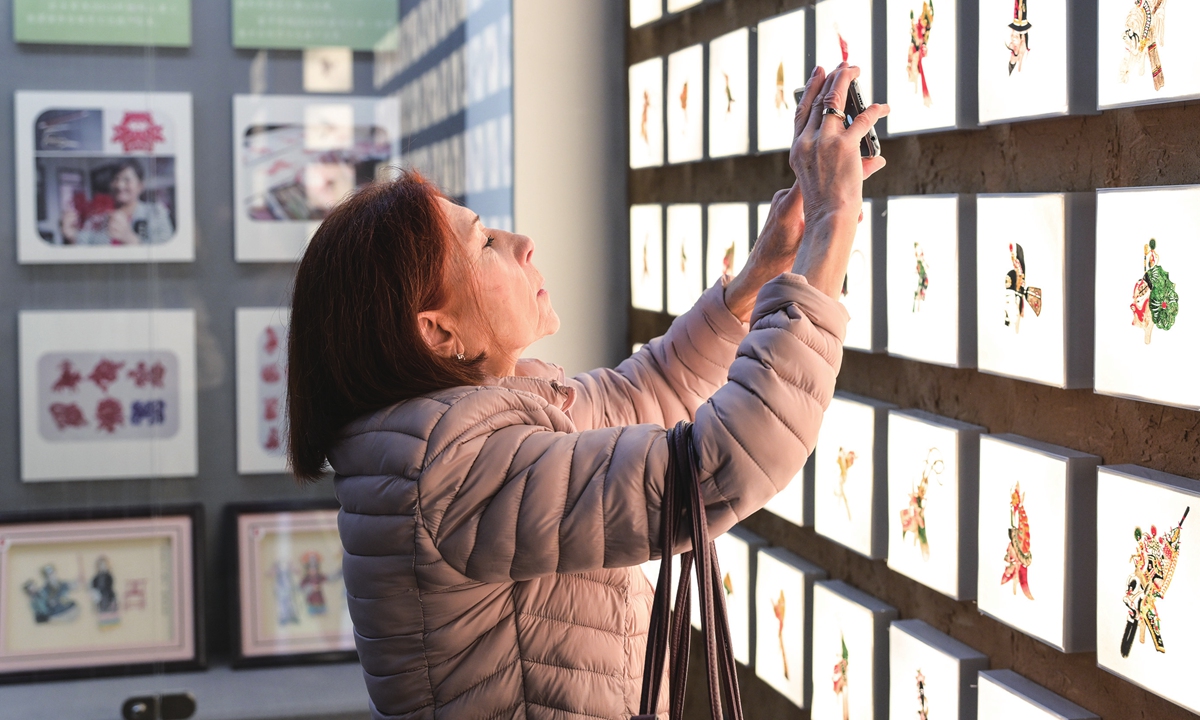
A group of traditional local opera artists perform on the stage. Photo: Bi Mengying/Global Times

A reporter from the delegation takes a photo of traditional Chinese papercutting in Xi'an, Shaanxi. Photo: Bi Mengying/Global Times
Xi'an, in Northwest China's Shaanxi Province, the ancient capital that has witnessed the rise and fall of 13 dynasties, is considered the starting point of the ancient Silk Road., Ahead of the 2023 Media Cooperation Forum on Belt and Road held in Beijing last week, the city welcomed a delegation of media representatives from 10 Belt and Road members hosted by the People's Daily.
"I visited Xi'an when the China-Central Asia Summit was being held there in May. I was deeply impressed by the city's dynamic energy fused with its long history and wanted to visit again. I'm very excited to return to Xi'an as there's so much to see and explore," Serik Korzhumbayev, editor in chief of the DK News Agency in Kazakhstan told the Global Times.
Inject history with new energy The delegation's itinerary was packed with visits to historical landmarks and archaeological sites, such as the Emperor Qinshihuang's Mausoleum Site Museum housing the famous army of Terracotta Warriors from the Qin Dynasty (221BC-206BC).
They also didn't miss the Huaqing Palace, a cultural landmark and former winter resort for emperors in the Tang Dynasty (618-907). Located at the foot of Lishan Mountain, the palace is famous for its hot spring, which was used for bathing by the royal family. According to the tour guide of the palace, some of the bathing pools were used by more than ten emperors of ancient China.
The palace is also known for the legendary love story of Tang Emperor Li Longji and his favorite concubine Yang Yuhuan. Nowadays it also hosts a spectacular musical drama called The Song of Everlasting Sorrow, which tells the tragic love story of Li Longji and Yang Yuhuan through music, dance and special effects.
The outdoor show artistically reimagines the touching love story, encapsulating the audience in a magnificent historical setting. The narrative, transcending language and national boundaries, deeply resonated with the audience, including the delegation members, regardless of their diverse cultural backgrounds.
Meanwhile, the delegation also visited a Tang Dynasty-themed block, which has become a popular tourist spot in Xi'an.
After The Longest Day in Chang'an, a Chinese historical drama, was aired online in 2019, the elements of Tang Dynasty (618-907) culture started to make a comeback in China among the young generation.
Xi'an was the cultural center of the Tang Dynasty and the drama portrays that area, hence the local government replicated buildings and scenes from the popular drama and build a The Longest Day in Chang'an themed tourist block in the city, which turned out to be a huge success.
As the delegation walked around the block, they felt like that they had been transported through time to a thousand years ago. The visitors were awed by the eye-catching performances including song and dance shows, musical recitals and dramas. There were also many actors in the area taking on different roles, teaching the visitors traditional rituals or playing the role of vendors selling goods to give the visitors a better idea of how the daily life was like among ordinary people during the Tang Dynasty.
In many areas of the city, people dressed up in hanfu and some members of the delegation couldn't help taking photos of the beautiful costumes. "This is very normal in Xi'an. We are open to the fashion of today as well as that from the past," commented a local who was helping a delegation member take photos with a hanfu cosplayer.
Preserving tradition and moving forwardXi'an boasts a diverse culinary tradition that reflects its abundant historical and cultural heritage. The Muslim community in Xi'an, particularly in the Huimin Street area, has contributed to the city's culinary diversity, introducing a variety of meat dishes and snacks influenced by Islamic culinary traditions.
At the various restaurants and food stalls, visitors can find local specialties such as roujiamo, a hamburger-like street food made with shredded marinated lamb or beef stuffed into a flatbread bun, or yangrou paomo, mutton soup with steamed bread soaked in it.
Xi'an is also known for its wide selection of noodles, both cold and hot, which can be made from rice or from flour.
The delegation's adventure extended to a center at the Aiju Grain and Oil Industrial Group located at the Xi'an Free Trade Port. Here, donning chef hats, they engaged in a culinary journey, learning the art of making local food such as biang biang noodles, under the expert guidance of local chefs.
Biang biang noodles featuring thick, broad, hand-pulled noodles that are served with toppings like eggs, tomatoes, and beef. It is named after the sound made when the noodles are slapped on a table.
A chef told the reporters that a lot of parents take their children there as well to enjoy the fun-filled interactive learning experience. The workshops of the center were a lively representation of local heritage being passed down through generations.
At the center, the company also sells various imported products brought to Xi'an by the China railwayChang'an express freight train (Chang'an is the ancient name of Xi'an). A Kazakh member was excited to find some products from his hometown. Later, he was told that the flour and oil that he had just used to make the biang biang noodles were both from Kazakhstan.
As the delegations appreciated the view of the Xi'an Free Trade Port, where containers were being loaded and transported by machines, they saw with their own eyes how the Belt and Road Initiative (BRI) bridges distances between nations and fosters a closer bond, and better understood its profound significance on promoting culturalexchanges, people-to-people connectivity, andbuilding a global community with shared future.